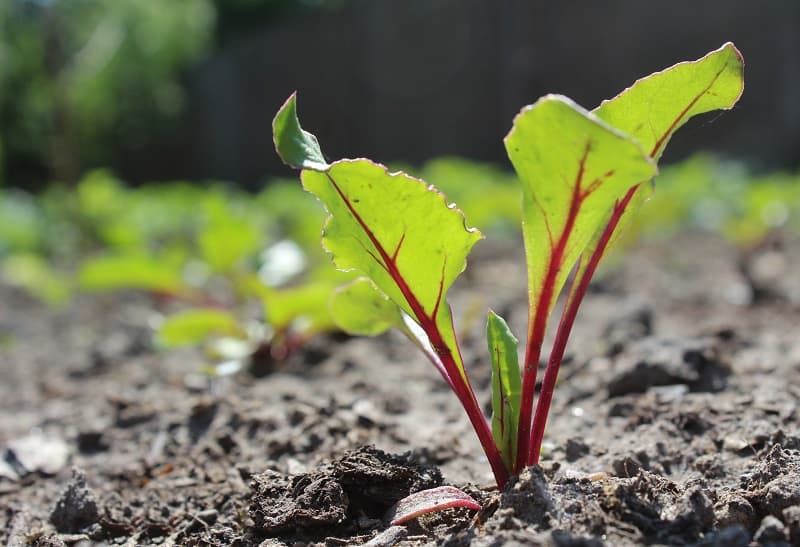
Beet plants – scientific name Beta vulgaris – are cool-season vegetable crops that can be grown anywhere. Although popular as root crops, all the plant parts are edible, with the red root beets being the more common variety. Mature beet plants are 12 to 18 inches tall and 18 to 24 inches wide, and prefer loamy soil. Just like other plants, these crops also suffer from diseases and conditions that cause yellowing leaves.
Common reasons for beet leaves turning yellow
Beet leaves could turn yellow because of certain diseases, such as Verticillium wilt, beet mosaic virus, black root rot or Cercospora leaf spot.
1. Verticillium wilt
Verticillium wilt is caused by soil-borne fungi that invade the roots of the plants. These fungi enter the sap pathways, resulting in the weakening and premature death of the beet plants.
The leaves change from yellow to brown and start to droop. This disease is prevalent in cool spring temperatures, and could also spread to other plant parts such as the stems.
Treatment for Verticillium wilt:
Remove any plants affected by this fungal disease. Prune the infected leaves and branches and dispose of the affected parts at once. Do not compost the infected plants, and disinfect your pruning equipment afterwards.
You can also use fungicides or seek the help of professionals to fumigate the soil. If you are in an area with warm weather, you can use plastic-covered soil to discourage the growth of fungi.
How to prevent Verticillium wilt:
Avoid planting the same crop in your garden for several years in a row. Ideally, you should wait for at least four years before you plant the same crop again. Be sure to remove the weeds and plant debris affected by the fungus so that it does not spread to other plants in the garden. Do not overwater your beet plants, as this creates a conducive environment for fungal growth.
2. Beet mosaic virus
This virus is usually spread by pests like aphids, whiteflies, leafhoppers and cucumber beetles. The younger leaves will develop yellow or white mottling and some leaves will have discolored rings before eventually falling off.
Treatment for beet mosaic virus:
There is no treatment for this virus. Once the plants are infected you cannot control it and should dispose of the affected plants.
How to prevent beet mosaic virus:
Check for the presence of pests on your plants and, if present, identify the type of pest. Use pest traps to exterminate them, or you can make a dish soap solution and spray it on the plants. You can also release natural pest predators like ladybugs into your garden. Use spot treatment options that are organic and non-toxic, such as neem oil, and consider planting the beets in late spring, as virus-carrying pests usually do not surface at this time of year.
Should the virus start to spread through the garden, prevent reoccurrence by cleaning the garden area during the fall season. Be sure to remove any residue or plant cuttings. Avoid planting your crop until the disease is eliminated, and never use fungicides as these cannot treat viral diseases.
3. Black root rot
Beet leaves turning yellow could also be due to black root rot. The leaves will start drooping and growth will be stunted. The condition causes problems with the root system and lateral roots become dry, shriveled and black. The leaves and beet bulbs become inedible.
Treatment and prevention of black root rot:
Black root rot is ideally treated with fungicides.
Some prevention measures include the following:
- Provide proper drainage for your beet plants.
- Establish a regular watering schedule.
- Always check the soil before watering.
- Be sure to aerate the soil to provide better oxygen flow.
4. Cercospora leaf spot
This disease is caused by the fungus Cercospora beticola, and is prevalent during late summer when the humidity and temperature are high. It is characterized by small, circular, brown spots on the beet leaves. The spots may turn gray and, in severe cases, the disease will spread from the outside leaves and the plant will not grow properly as the roots will also be affected.
Treatment for Cercospora leaf spot:
Remove infected leaves and dispose of them properly. Use fungicides to treat the disease; try to use multiple types as some strains are resistant to certain fungicides.
How to prevent Cercospora leaf spot:
Remove weeds and plant debris from around infected plants, because the disease can survive in the soil for two years. This will avoid further spread of the disease to other parts of your garden. Treat seeds with hot water or fungicides before you plant them and avoid getting moisture on the leaves through overhead irrigation as this can encourage growth of the fungus.
Water the plants during the daytime when the leaves are dry, and improve the air circulation in your garden to discourage fungal growth.
5. Pests on your beet plants
Beet leaves turning yellow could also be due to the presence of pests such as aphids. These insects suck on the sap or juice of plant tissue, causing the plants to weaken and the leaf color to change from bright green to a sickly yellow. To control these pests, use insecticidal soaps or spray your plants with a water hose.
Conclusion
Yellowing beet leaves could be attributed to fungal or viral diseases such as Verticillium wilt, beet mosaic virus, black root rot or Cercospora leaf spot. It could also be due to pests in your garden, such as aphids, which feed on the sap of plant tissue.
Image: istockphoto.com / Imladris01